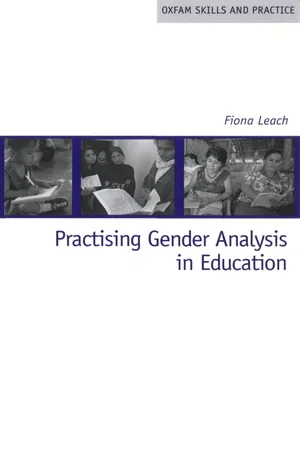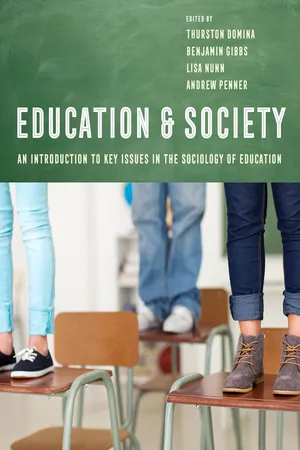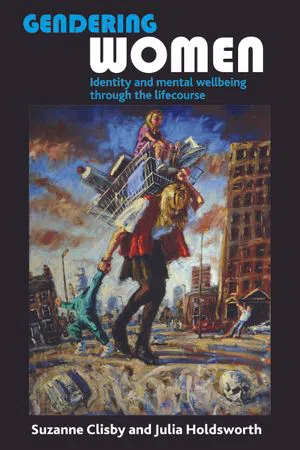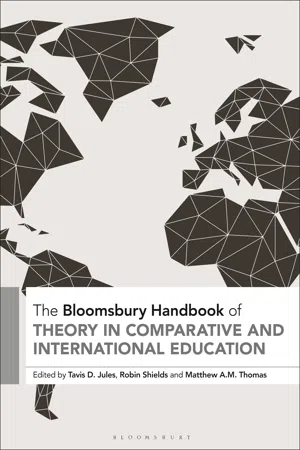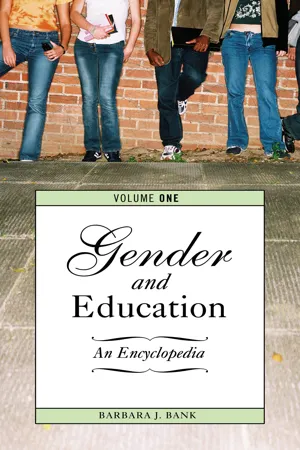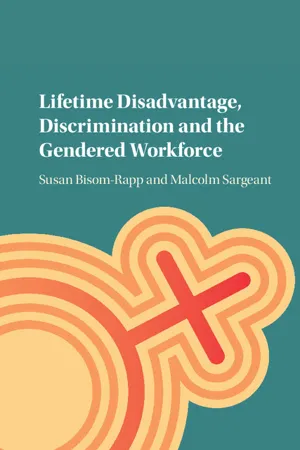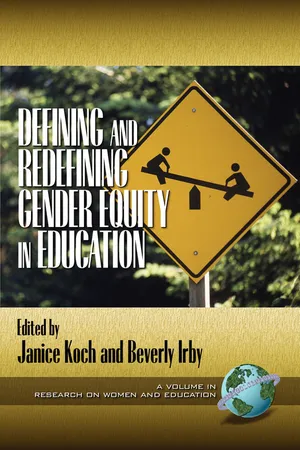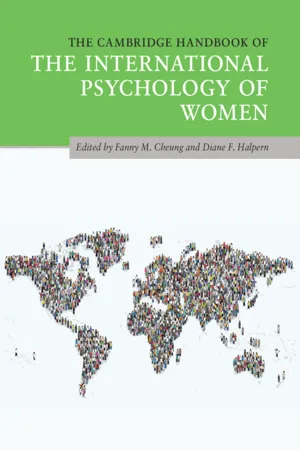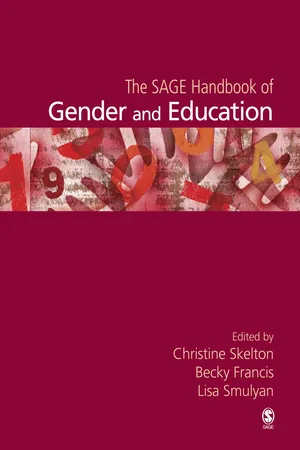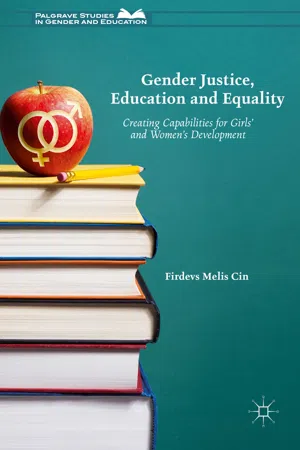Social Sciences
Gender and Education
Gender and education refers to the study of how gender influences educational experiences, opportunities, and outcomes. It encompasses the examination of gender disparities in access to education, curriculum content, teaching methods, and the impact of societal expectations on educational achievement. This field also explores strategies to promote gender equality and inclusivity within educational institutions.
Written by Perlego with AI-assistance
Related key terms
1 of 5
10 Key excerpts on "Gender and Education"
- eBook - PDF
- Fiona Leach(Author)
- 2003(Publication Date)
- Oxfam(Publisher)
Increasingly, social science research intersects gender with other social categories, for example, gender and race in the classroom, gender and class in the workplace. Fundamental to gender relations is the concept of power and its unequal distribution. Gender identity and gender relations are performed differently in different contexts and they may change over time. This can be seen in the way in which the social and economic roles of women have become much less restrictive in many countries, largely as a result of economic development and industrialisation. This has created job opportunities for women and given them unprecedented levels of economic independence. The feminist movement has also been powerful in changing gender relations and perceptions of appropriate roles for women, with more women now being seen in visible public positions, for example, as Members of Parliament and government ministers. Schools have certainly served to widen girls’ horizons in particular, and co-educational schools have the opportunity to foster constructive interaction and mutual understanding between the sexes from an early age. At the same time, highly defined gender relations between female and male pupils, between female and male teachers, and also between teachers and pupils (and in some cases between head teachers and teachers), continue to be a prominent feature of all co-educational schools. This is not surprising, because to a large extent schools reflect norms of behaviour which exist in the wider society. Gender roles These are patterns of behaviour that assign specific tasks, responsibilities, and obligations to men and women. Gender roles are determined by social and Key concepts in Gender and Education 17 economic factors and by the norms and values that underpin what we do. As such, they are also dynamic and subject to change. They help to determine the amount of power and status accorded to individuals. - eBook - ePub
Education and Society
An Introduction to Key Issues in the Sociology of Education
- Dr. Thurston Domina, Dr. Benjamin G. Gibbs, Dr. Lisa Nunn, Dr. Andrew Penner(Authors)
- 2019(Publication Date)
- University of California Press(Publisher)
Similarly, theories of gender essentialism argue that cultural beliefs that women and men are fundamentally and innately different from one another underlie the maintenance of gender inequality in education (Charles and Bradley 2002). Researchers with this perspective argue that while the United States and many other advanced industrial societies value egalitarianism (including the belief that males and females should generally have access to the same educational resources), cultural beliefs about essential differences between men and women remain strong and, at the same time, drive the continued gender segregation of fields of study. Thus, while it is culturally acceptable for women to receive the same amount of education as men (and even a little more), this progress toward equality is circumvented by social forces that continue to define some subjects (e.g., math and science) as “naturally suited” for men, and other subjects (e.g., humanities, social sciences) as “naturally” suited for women.From a slightly different perspective, many sociologists theorize that gender is a social construction (Ridgeway and Correll 2004), arguing that it is a social category or schema created and reinforced by interactions and institutionalized through systems at the macro level. This theory acknowledges both the maintenance of gender inequality and the potential to disrupt it, arguing, for example, that local environments have the potential to subvert larger social stereotypes about gender and, in doing so, promote change. As a result, this theory acknowledges that individuals have agency, that they are not simply passive recipients of stereotypes and norms. Peering through the lens of gender as a social construction, researchers call explicit attention to the interplay between individual expectations and behaviors in local settings, such as classrooms, where, for example, female and male students might have very different interactions and experiences. For example, a female student who performs well in a math class might not receive the same recognition from either teachers or peers as a comparable male student, owing to the continued salience of gender stereotypes. - Suzanne Clisby, Julia Holdsworth(Authors)
- 2014(Publication Date)
- Bristol University Press(Publisher)
101 FIVE Gendering education: the paradox of success versus status Introduction Our experiences of schooling and education have far-reaching impacts on our lives. Educational institutions are profoundly gendered arenas and also key sites through which the effects of the symbolic, structural and physical violence of gendering can be felt. In this chapter we explore the intersections between education, aspiration, achievement and wellbeing. In considering education we address a range of different areas, from formal school and institutionally-based education to the more subtle forms of education that girls and women receive through processes of socialisation that teach them, for example, appropriate ways of carrying their bodies and expressing their thoughts. Considering education in relation to wellbeing and confidence allows us to see that, for many girls and women, as well as boys and men, experiences of formal education are both shaped by, and shape, female and male identities and beings. This means that it is important to pay attention to the gender regimes that structure educational systems. A significant range of research has demonstrated the ways in which the institution of education is deeply implicated in processes of gendering (Arnot et al, 1999; Ringrose and Epstein, 2008; Bradley, 2013). Given that schools perform a large portion of the task of moulding good citizens it is critical that we understand how gender relations are reflected and reproduced in education at different levels. At an ideological and symbolic level messages about gender, along with other significant identifiers such as race, class and ethnicity serve to socialise young people into expecting and accepting their future roles. At structural and organisational levels, overt and covert practices inform young people about the relative power of different groups and individuals, as well as what kinds of knowledge and ability are deemed most valuable (Murphy, 1996; Ringrose and Epstein, 2008).- Tavis D. Jules, Robin Shields, Matthew A. M. Thomas, Tavis D. Jules, Robin Shields, Matthew A. M. Thomas, tavis d. jules(Authors)
- 2021(Publication Date)
- Bloomsbury Academic(Publisher)
CHAPTER NINEGender in Comparative and International Education
Gender as Noun, Adjective, and Verb
LAURA WANGSNESS WILLEMSEN and PAYAL SHAHINTRODUCTION
Scholars have focused on gender within comparative and international education (CIE) since the field’s inception. As far back as 1817, Marc-Antoine Jullien (1775–1848) examined girls’ education and its implications for relationships between women and men (Janigan and Masemann, 2008). In the ensuing years, as feminist and development theories both gained greater influence, the field has expanded to attend to a wide variety of gender-related issues, such as access, inclusion, pedagogies, parity, equality, curricula, equity, intersectionality, masculinities, agency, empowerment, and methodologies. Yet, these developments have been nonlinear and contested: this chapter will demonstrate how some conceptualizations of Gender and Education popularized nearly fifty years ago remain in use today, alongside and in occasional tension with newer conceptualizations. At the same time, the emphasis on education for girls and women in relation to larger social, political, economic, and material contexts—first evidenced as an area worthy of attention some two hundred years ago by Jullien—continues to be taken up anew in the current work of scholars, practitioners, and policymakers alike. In short, gender work in the field of CIE has both deep roots and new, evolving branches.The purpose of this chapter is to introduce several influential perspectives on gender within the field of CIE. We focus on the developments within the last fifty years, when feminist thought began to alter the shape of the social sciences and when CIE began to more closely intersect with international development work. To do so, we draw on Unterhalter’s (2007) observation that the term “gender” has been variously used as a noun, adjective, and verb in the field of CIE and the closely related field of international development. Even as “gender” continues to be used all three ways, each usage—each part of speech—can be seen as corresponding to the development of different theoretical paradigms at the nexus of gender, education, and development.- eBook - PDF
Gender and Education
An Encyclopedia [2 volumes]
- Barbara J. Bank(Author)
- 2007(Publication Date)
- Praeger(Publisher)
Others, however, point out that gender is about both men and women; that it is about our constructed notions of what constitutes masculinity and femi- ninity; and that sexual practices as well as the political construction of acceptable sexual- ity create many of the constraints that women and men experience. 372 Gender and Education In 2006, within the United States there existed over 600 academic interdisciplinary pro- grams that were organized around the study of women and gender. Of these, slightly over 100 called themselves gender studies, or women’s and gender studies, or, to a much less extent, feminist, gender, and sexuality studies. Are these all the same kind of studies with just idiosyncrasies in the naming? At Cornell, for instance, where a shift in name and focus took place in 2002, the feminist, gender, and sexuality studies program describes a unit that is intended to bring attention to the intertwining of gender and sexuality with power and inequality. Cornell first added a lesbian, bisexual, and gay studies minor in the early 1990s to the women’s studies program. The original women’s studies program, so named to highlight the ways in which the traditional curriculum marginalized women as the “Other,” no longer seemed sufficient either politically or theoretically. Similarly, at Indiana University, the shift from women’s studies to gender studies, which took place in the mid-1990s, was intended to reflect the ways in which theorizing and knowledge about women and gender have evolved and become more complex. Organizationally, women’s studies and gender studies departments and programs still must resolve the generational problem. The newest trend in this decade has been to secure faculty lines within programs and departments where these core faculty have primary responsibility for the curriculum, for hiring and policy decisions, and for establishing new degree programs. - Susan Bisom-Rapp, Malcolm Sargeant(Authors)
- 2016(Publication Date)
- Cambridge University Press(Publisher)
2 Education and Training Our model begins with a focus on the foundational experiences of girls and young women, which may decisively and negatively impact their career trajectories and earning potential. Whilst education and training is an area where there have been global advances, significant gender-based deficiencies remain. In the developing world, significant obstacles to educational access are experienced by many children, especially girls. In contrast, in developed countries, girls and young women are failing in large numbers to train for traditionally male-dominated and lucrative careers in the science, technol- ogy, engineering, and mathematical fields. By focusing on outcomes, and accounting for the causal aspects of educational gender disparities – the role of families, schools, and the societal norms – policymakers may begin to craft more effective solutions for the challenges that remain. Educational Gender Gaps Any society that aims to equalise economic outcomes for men and women during and after the end of their working lives must begin by providing equal access to education. Thereafter, a country must provide young men and women with equal opportunities to utilise that education in developing work and career choices. Also relevant to evaluating each nation are the levels of educational attainment for men and women, and educational performance differentials. When it comes to education and training, there are vast differences in the position of girls and women in the developed versus the developing world. Even so, one can assess the state of gender equality in any country by examining the educational gender gaps within it. The Global Gender Gap Report is the World Economic Forum’s annual assessment on national progress towards eliminating gender disparities.- Janice Koch, Beverly Irby(Authors)
- 2014(Publication Date)
- Information Age Publishing(Publisher)
Included in this platform were provisions for the advancement of gender equity in education, with an entire section devoted to resolutions on that topic. The declaration specifically states: Education is a human right and an essential tool for achieving the goals of equality, development and peace. Non-discriminatory education benefits both girls and boys and thus ultimately contributes to more equal relation-ships between women and men. Equality of access to and attainment of edu-cational qualifications is necessary if more women are to become agents of change. (United Nations, 1995). Gender Equity in Education is One Component of a Broader Concept of Gender Justice Issues. Both in and outside of a schooling context, there has been a substantial focus on many aspects of the well being of girls and women, as well as on that of boys and men. Since women rather than men have traditionally been 10 S. KLEIN, P. ORTMAN, and B. FRIEDMAN neglected regarding their equitable treatment and outcomes, and since women’s studies is a well-developed field in its own right, most of the gender equity topics and organizations inside and outside of education focus on females. However, there are men’s studies and gender studies and organiza-tions as well (see Table 2). Table 2. Examples of National and International Nongovernmental Organizations Involved in Gender Equity and Education Organizations whose primary focus is gender equity in education: • AAUW: the American Association of University Women www.aauw.org • American Men’s Studies Association (contact [email protected] ) • GenderWatchers International Gender Organization www.genderwatchers.org • Myra Sadker Advocates for Gender Equity www.sadker.org • NAPE: National Alliance for Partnerships in Equity, Inc.- Fanny M. Cheung, Diane F. Halpern(Authors)
- 2020(Publication Date)
- Cambridge University Press(Publisher)
However, broader societal factors such as educa- tional policy and vocational tracking also play a role in determining field-by-gender distributions. For example, in some non-Western and less individualistic societies, girls and boys are required to take the same number and level of math and science courses until upper secondary school (Li et al., 2018), thereby minimizing potential gaps between girls and boys in academic experiences. Indeed, gender differences in achievements are either not found or favor girls in these cases (Liu, 2009). Relatedly, in many Middle Eastern countries, in which traditional gender roles still prevail (e.g., Saudi Arabia, Jordan, Iran), women participate at higher rates in STEM domains, including engineering and technical professions, than in American and European countries (DeBoer & Ater Kranov, 2017). Though this may be partly explained by economic consid- erations at the individual level, restrictions laid by social policy likely play a role. For example, in Jordan and Tunisia, students are tracked into higher education domains based on the country’s needs more than on indi- viduals’ interest (Weingarten, 2017). In the former Soviet Union (e.g., Gerber & Schaefer, 2004), state policy has not usually made a distinction in suitability between STEM and other academic tracks based on gender, thereby fostering – in spite of otherwise not being a liberal society – more gender-equal perceptions of academic development. Obviously, we do not wish to promote a message against freedom of choice, but rather seek to highlight how socially malleable gendered perceptions of academic fields can be. Grades and Other School-Specific Factors An important indicator of successful schooling is the grades given by teachers, which are integral to formal education and play a critical role in educational development.- eBook - PDF
- Christine Skelton, Becky Francis, Lisa Smulyan, Christine Skelton, Becky Francis, Lisa Smulyan(Authors)
- 2006(Publication Date)
- SAGE Publications Ltd(Publisher)
In 2003, UNESCO estimated that girls and women, worldwide, comprised two-thirds of the one billion people with little or no education (UNESCO, 2004). Poverty, global inequality and gender discrimination scar the political, economic and social landscape of too much of the world and powerfully shape the academic, activist and policy literature on gender, education and development. This chapter first out-lines some changing features of gender inequalities in access to schooling in devel-oping countries as measured by official statistics and then contrasts the ways in which different disciplinary assumptions about gender and development have engaged with the picture this presents and the policy challenges in this field. EXPANDING GENDER EQUALITY IN ACCESS TO EDUCATION From the beginning of the twentieth century, nationalist movements in Asia, Africa and Latin America fostered aims to expand education. Post-war decolonization saw new governments establishing mass systems of schooling linked to projects of national development. These expanded the limited provision of the colonial era when education had been largely for élites and was only sporadically available to the rest of the population in under-resourced schools (Carnoy and Samoff, 1990). But expansion of access to education was not uniform. Regional and social inequalities, magnified by gender, were reflected in who did and did not enrol in school. Table 7.1 shows the growth of enrolment in primary and secondary school by gender in different parts of the world since the 1960s. 7 Gender, Education and Development 1 E l a i n e U n t e r h a l t e r Although the proportion of girls and boys in primary school has risen in every region the gender gap, evident in all regions (except North America, Western Europe, Latin America and the Caribbean) in the 1960s had only been eradicated in 2000 in East Asia, persisting, despite some narrowing, in all other regions. - eBook - PDF
Gender Justice, Education and Equality
Creating Capabilities for Girls' and Women's Development
- Firdevs Melis Cin(Author)
- 2017(Publication Date)
- Palgrave Macmillan(Publisher)
With the younger generations, poverty was not so great a concern, whereas their aspiration to achieve a level of gender equality in their lives through education was prominent. They val- ued the social capability of being treated on equal terms, building more gender equitable families/relations and leading a life without any societal and gender restrictions. This variation suggests the link between educa- tion, gender and poverty that Unterhalter (2012a) has described: With poverty, the sexual division of labour at home is associated with the eco- nomic relations of survival, and therefore it becomes difficult for women to transform the gender relationships which are embedded in their lives. Even schooling as a means for rising above the poverty threshold does not guarantee that the individual will develop the ability to challenge gender inequalities, because inequalities also exist in schools (such as distribution and inequitable gender norms, misrecognition of certain groups, girls or minorities). This was the case particularly for the Republican generation of women, as I will explain in the next section. Thus, the poverty and enmeshed gender inequalities of Republican women’s natal families did not necessarily lead the women to conceptualise gender equality as an important capability to aim for through education, unlike the younger generations. EDUCATION PROCESSES Experiences of education processes that emerged from interviews included curriculum, extra-curricular activities provided by the school; pedagogical approaches to girls’ learning; the socio-political setting of the schooling experience; and the school environment.
Index pages curate the most relevant extracts from our library of academic textbooks. They’ve been created using an in-house natural language model (NLM), each adding context and meaning to key research topics.
